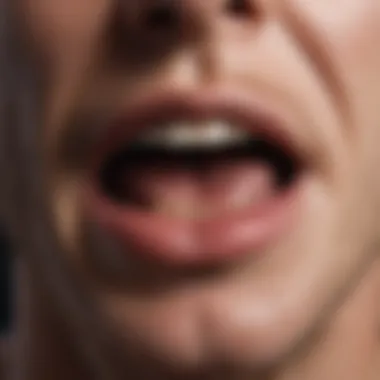Understanding Skin Cracking at the Mouth Corners


Intro
Skin cracking at the corners of the mouth, medically recognized as angular cheilitis, can be an inconvenient and sometimes painful condition. This issue may arise from a variety of underlying factors, ranging from nutritional deficiencies to environmental irritants. It can affect individuals regardless of age or gender and often remains unnoticed until symptoms become pronounced.
This article aims to explore the multiple dimensions of angular cheilitis. We will investigate potential causes, the physiological processes involved, and effective prevention strategies. Moreover, a wide array of treatment options will be examined, emphasizing the necessity for professional guidance in managing this condition.
Understanding the nuances of skin cracking and its implications is critical. Armed with this knowledge, readers can make informed decisions about their health, allowing for proactive management of symptoms and contributing to overall wellness.
Prelude to Angular Cheilitis
Angular cheilitis, often overlooked, merits attention due to its multifaceted nature and impact on oral health. This condition presents as painful cracks or sores at the corners of the mouth. Understanding this issue is essential not only for those experiencing symptoms but also for health professionals who may encounter patients with related concerns.
The importance of this introduction lies in identifying the condition early. Awareness of angular cheilitis can lead to proper diagnosis and effective management. Many people may dismiss initial signs as simple chapping. However, as the symptoms progress, the physical discomfort can escalate, leading to complications in eating, speaking, and overall quality of life.
In exploring the details of angular cheilitis, it is crucial to understand its underlying causes. This condition is not merely an isolated skin issue; it often signals broader nutritional deficiencies, environmental influences, or even systemic health problems. By comprehending these aspects, readers—particularly healthcare professionals—can appreciate the interconnectedness of skin conditions and general health.
Through this section, we aim to provide a foundational insight into angular cheilitis. The information presented here will guide health professionals, nutritionists, and wellness coaches in recognizing symptoms and considering a holistic approach to treatment. From understanding patient experiences to formulating preventive strategies, grasping the significance of this condition is both relevant and necessary.
"Knowledge of angular cheilitis is essential for appropriate care and interventions, potentially transforming patient outcomes."
In summary, this exploration will lay the groundwork for a more in-depth examination of angular cheilitis. It emphasizes vigilance in recognizing symptoms, understanding their causes, and considering appropriate preventive measures. This foundational knowledge is crucial in managing not only angular cheilitis itself but also associated conditions.
Definition and Symptoms
Understanding the definition and symptoms of angular cheilitis is crucial for those affected by skin cracking in the corners of the mouth. Recognizing these features allows individuals to take appropriate actions and seek treatment early, preventing further complications. Moreover, this knowledge aids health professionals in making accurate diagnoses and advising patients effectively.
Physical Definitions
Angular cheilitis is characterized by inflamed, cracked skin typically occurring at the corners of the mouth. The damaged area may appear red or swollen, although the intensity can vary among individuals. These visible signs could lead to embarrassment or discomfort, affecting one’s confidence and daily life. Describing this condition accurately assists both patients and healthcare providers in understanding the underlying issues contributing to these physical manifestations.
Common Symptoms
Identifying common symptoms helps in recognizing angular cheilitis quickly. The main symptoms include pain and discomfort, itching and redness, as well as visible cracks. Each of these contributes to the overall experience of the condition and signifies how severe the problem might be.
Pain and Discomfort
Pain and discomfort are often the most immediate and distressing symptoms experienced by individuals with angular cheilitis. This sensation can hinder everyday activities such as eating and speaking, significantly affecting quality of life. Unbearable discomfort serves as a clear signal for individuals to seek treatment. It is essential to address this symptom effectively, as chronic pain may lead to additional issues, both physically and mentally.
Itching and Redness
Itching and redness usually accompany the physical cracks at the mouth corners. This discomfort can lead to incessant scratching, further exacerbating the initial problem. The key characteristic of itching is its ability to draw attention to the affected area, prompting individuals to examine their condition. Recognizing these symptoms can lead to timely intervention, mitigating more severe consequences.
Visible Cracks
Visible cracks are the hallmark of angular cheilitis and indicate significant underlying issues. These cracks can vary in intensity and may sometimes bleed, increasing the risk of infection. The presence of visible cracks serves not just as an aesthetic concern but as a primary indicator that something deeper may be wrong, such as nutritional deficiencies or environmental irritants. Acknowledging this symptom allows for focused investigation into the factors contributing to the condition.
Proper understanding of these symptoms can lead to effective management and treatment, enhancing the healing process and improving overall well-being.
Common Causes
Understanding the common causes of angular cheilitis is crucial. This condition can stem from various factors. Identifying the root cause aids in preventing and treating the condition effectively. By recognizing these causes, individuals can make informed decisions about their health habits.
Nutritional Deficiencies
Nutritional deficiencies play a significant role in the development of angular cheilitis. When the body lacks essential vitamins and minerals, it can lead to weakened skin integrity and increased susceptibility to cracks. Monitoring dietary intake helps prevent these deficiencies.
Vitamin B Deficiencies


Vitamin B deficiencies are particularly relevant. These vitamins help maintain healthy skin and mucous membranes. A lack of vitamin B2, for instance, can cause cracks at the corners of the mouth. Recognizing signs of this deficiency is beneficial for overall well-being.
The key characteristic of vitamin B deficiencies is its widespread effects on various bodily functions. This makes understanding its role in skin health important. Including foods rich in vitamin B, such as leafy greens and whole grains, can enhance skin resilience. However, it is crucial to consult with a healthcare provider before starting any supplementation. This ensures it complements individual health needs.
Iron Deficiency
Iron deficiency is another common factor contributing to angular cheilitis. Iron helps carry oxygen in the blood, essential for skin repair and regeneration. Low iron levels can lead to pale skin and cracks in sensitive areas. Thus, maintaining adequate iron intake is important.
A noteworthy aspect of iron deficiency is how it can affect energy levels. This can impact general health, not just skin condition. Eating iron-rich foods like red meat and legumes can support skin health. However, excessive iron intake can also lead to complications. Hence, balance is necessary.
Zinc Deficiency
Zinc deficiency is also significant in the context of angular cheilitis. Zinc is vital for skin repair and immune function. A lack of zinc can slow down healing and make the skin more prone to irritations.
The distinct feature of zinc's role in skin health is its involvement in collagen synthesis. This process is vital for maintaining skin elasticity and integrity. Incorporating zinc-rich foods, such as shellfish and nuts, can bolster skin health. Nevertheless, over-supplementation can lead to adverse effects, warranting caution in intake.
Environmental Factors
Environmental factors contribute to angular cheilitis as well. Elements such as weather conditions and pollution can irritate the skin around the mouth. Being aware of these factors can help individuals take preventive measures.
Cold Weather Effects
Cold weather effects can aggravate skin conditions, including angular cheilitis. Dry air can cause skin to lose moisture, leading to cracks. Understanding this relationship is crucial for effective management during colder months.
One notable aspect of cold weather is its ability to reduce humidity in the air. This can lead to more pronounced symptoms in sensitive individuals. Using a humidifier indoors can help mitigate these effects, promoting better skin hydration.
Sun Exposure
Sun exposure is another environmental cause to consider. Prolonged exposure to UV rays can damage the delicate skin around the mouth. This can lead to cracks and discomfort. Being mindful of sun protection is essential to skin health.
Sun damage can have long-term effects on skin appearance and integrity. Wearing lip balm with SPF and avoiding direct sunlight during peak hours can help protect sensitive skin.
Air Pollution
Air pollution can also play a role. Pollutants can irritate the skin, exacerbating conditions like angular cheilitis. Understanding the impact of pollution on skin health is increasingly important in urban settings.
The unique feature of air pollution is its ability to weaken the skin's barrier. This makes skin more reactive to other irritants and infections. Using gentle, anti-inflammatory skincare products can help protect against these external sources of irritation.
Underlying Health Conditions
Several underlying health conditions can precipitate angular cheilitis. Awareness of these conditions can prompt timely evaluations and interventions.
Diabetes
Diabetes is a significant factor in skin health. Individuals with diabetes often experience a decreased ability to heal, which can exacerbate cracks in the skin. Proper management of blood sugar levels is vital for skin integrity.
The crucial characteristic of diabetes in this context is its potential to cause neuropathy, leading to reduced blood flow. This affects the skin's healing capabilities. Regular monitoring and consultations can be beneficial for maintaining skin health in diabetic patients.
Autoimmune Diseases
Autoimmune diseases can also increase susceptibility to angular cheilitis. Conditions like lupus and psoriasis can lead to heightened skin sensitivity and inflammation. Recognizing these conditions is important for comprehensive care.
The unique aspect of autoimmune diseases is their propensity to cause systemic inflammation. This makes skin more vulnerable to external irritants. Treatment should be tailored to the individual, focusing on managing the autoimmune condition to benefit skin health.
Fungal Infections
Fungal infections can contribute to angular cheilitis as well. They often create an environment conducive to skin irritation and cracking. Understanding how fungal infections can present in this context is beneficial for treatment.
A key characteristic of fungal infections is their contagious nature. Areas with compromised skin integrity can become breeding grounds for infections. Early treatment with antifungal agents can help prevent further complications and promote healing.


Preventive Measures
Preventive measures are critical in the management of skin cracking at the corners of the mouth, or angular cheilitis. By understanding and implementing these strategies, individuals can significantly reduce the risk of developing this condition. Addressing hygiene, ensuring balanced nutrition, maintaining hydration, and proper moisturization can all contribute to preventing the issue or curtailing its impact. These measures allow individuals to actively manage their health and well-being.
Maintaining Hygiene
Hygiene plays a vital role in preventing angular cheilitis. Regular cleaning of the mouth area is essential to minimize the accumulation of bacteria and irritants. Washing the face and the corners of the mouth can remove food particles and other debris, which can lead to irritation and infection. It is advisable to use mild, fragrance-free soaps that do not further irritate sensitive skin.
Moreover, avoiding the habit of licking the lips or the corners of the mouth can help maintain skin integrity. Saliva can create an environment conducive to yeast infections, which aggravate the condition.
Dietary Adjustments
Balanced Nutrition
Balanced nutrition is a cornerstone in the prevention of angular cheilitis. A diet rich in vitamins, minerals, and other essential nutrients supports skin health. Key vitamins like B2, B6, and B12 are particularly important; they play a significant role in skin repair and regeneration. Consuming a variety of colorful fruits and vegetables, whole grains, and lean proteins ensures that the body gets a wide range of nutrients.
In this context, balanced nutrition is a beneficial choice as it addresses not only skin issues but overall bodily health. Its unique feature lies in the holistic support it provides to various bodily systems, thus tackling deficiencies that may contribute to angular cheilitis.
Hydration Importance
Hydration is another crucial aspect when considering prevention. The skin, including the delicate area around the mouth, requires adequate moisture to remain supple and resilient. Drinking sufficient water is vital for maintaining skin elasticity and preventing dryness, conditions that can lead to cracks.
This aspect of hydration is particularly popular for its simplicity and immediate benefits. Although the need for hydration is a basic requirement of life, its unique role in skin condition management cannot be underestimated, as it directly impacts skin health and integrity.
Supplement Recommendations
Sometimes, it may be necessary to supplement the diet, especially when deficiencies are present or dietary restrictions are in place. Supplements containing vitamins A, C, E, and B-complex vitamins can foster healthy skin. They are a beneficial option when dietary intake falls short, providing a concentrated source of necessary nutrients.
The unique feature of supplements is their ability to deliver focused support, particularly in cases where food alone may not suffice. However, it is always advisable to consult with a healthcare professional before starting new supplements.
Adequate Moisturization
Choosing the Right Products
Selecting the right moisturizing products is essential for preventing skin cracking. Products that contain emollients, humectants, and occlusives are often recommended, as they help retain moisture and protect the skin barrier. Look for ingredients like glycerin, shea butter, and ceramides in creams or ointments.
This aspect is crucial because quality products can directly impact the effectiveness of hydration efforts. Choosing the right products is a practical beneficial choice, as it enhances skin protection and resilience, minimizing the risk of angular cheilitis.
Frequency of Application
Establishing a consistent routine for applying moisturizers is important. Regular application helps maintain moisture levels and supports the skin's natural barrier function. For optimal results, applying moisturizer multiple times a day is recommended, particularly after exposure to water or extreme weather conditions.
The frequency of application is a beneficial strategy as it keeps skin hydration levels stable. However, it does demand diligence and awareness, which some may find challenging.
Natural Remedies
In addition to commercial products, natural remedies can also support skin health. Options such as coconut oil, shea butter, and beeswax have proven effective in providing moisture and protection. These remedies are often well-tolerated and can be used alongside other preventive measures.
Natural remedies are viewed as a popular choice among those seeking holistic alternatives. Their unique feature is that they often come with fewer side effects compared to synthetic products. However, efficacy varies by individual, and some may not respond as well to natural options.
Treatment Options
The topic of treatment options is crucial for anyone dealing with angular cheilitis. Finding effective solutions can significantly improve quality of life. Understanding the variety of treatment approaches gives individuals the means to quickly address their symptoms. Fortunately, treatments can range from over-the-counter topical applications to more intensive medical interventions. Each approach offers its own set of advantages and considerations, making it important to explore the different paths available.
Topical Treatments
Topical treatments are often the first line of defense against angular cheilitis. These contain specific active ingredients designed to soothe irritation and promote healing. They can reduce inflammation and provide immediate relief from symptoms.
Home Remedies


Home remedies can be an accessible and effective way to alleviate symptoms of angular cheilitis. Utilizing readily available products allows individuals to manage their condition without always needing to visit a healthcare provider.
Coconut Oil Applications
Coconut oil applications are a beneficial choice due to their natural moisturizing properties. The composition of coconut oil supports skin hydration, a key factor in healing cracks. It is popular because it is gentle and contains antimicrobial properties. This can help prevent potential infections in the cracked skin. However, one must consider potential allergies. Some individuals may find that it does not adequately absorb, leaving a greasy residue.
Aloe Vera Usage
The use of aloe vera is another effective home remedy for angular cheilitis. Aloe vera is appreciated for its cooling and soothing characteristics. It helps in reducing inflammation and promoting skin healing. Its natural composition aids in hydration and cell regeneration, which is crucial for repairing cracks. One drawback is that while it is widely available, its effectiveness may vary based on individual reactions. Some may need to combine it with other ingredients for better results.
Natural Oils
Natural oils, such as argan or jojoba oil, provide additional options for managing angular cheilitis. These oils are rich in essential fatty acids, which help maintain skin moisture and elasticity. They are beneficial since they often contain vitamins that support skin health. However, like coconut oil, some oils may not be suitable for everyone. The thickness can sometimes lead to a sense of suffocation on the skin, which may discourage consistent use.
Medical Interventions
In more severe cases, medical interventions may be necessary. These interventions are tailored to effectively address underlying issues and provide fast relief from intense symptoms. While they may be more invasive than the above treatments, they can also yield quicker results.
Prescription Creams
Prescription creams often contain stronger active ingredients like hydrocortisone or antifungals. They specifically target inflammation and infections that are common in angular cheilitis. Their strength makes them a popular choice for those who do not see improvements with over-the-counter remedies. However, a healthcare provider's guidance is crucial for safe and appropriate use, as misuse can lead to side effects or worsening conditions.
Injections for Severe Cases
Injections might be considered for those with persistent symptoms that do not respond to other treatments. Corticosteroid injections can reduce inflammation quickly and efficiently. This method is beneficial for immediate relief, but it may not be the first choice due to the need for qualified healthcare personnel to administer it. The potential for side effects exists, and appropriate monitoring is necessary.
Underlying Condition Treatment
Finally, addressing any underlying conditions related to angular cheilitis is essential for long-term care. For instance, managing diabetes or fungal infections can eliminate the recurrence of symptoms. This approach is beneficial, as it targets the root causes rather than just the symptoms. Thus, consulting with a healthcare provider to determine the right course of treatment is vital.
When to Seek Professional Help
Recognizing when to consult a healthcare professional regarding skin cracking at the corners of the mouth, or angular cheilitis, is crucial for timely and effective intervention. This condition may appear mild initially but can indicate underlying health issues or lead to complications if left untreated. Seeking professional guidance helps identify the cause, appropriate treatments, and preventative measures necessary to alleviate discomfort.
Recognizing Severe Symptoms
Severe symptoms of angular cheilitis include persistent pain, swelling, and significant bleeding. If the cracks become deeper and more pronounced, they can impede eating, speaking, and other daily activities. Other red flags may include:
- Development of lesions or sores that do not respond to over-the-counter treatments.
- Signs of systemic infection, like fever or excessive swelling around the mouth.
- Symptoms that escalate rapidly or last longer than two weeks without improvement.
Awareness of these symptoms is essential. In some incidents, skin cracking can be a marker for deficiencies or underlying diseases. It is sensible to monitor changes and seek help promptly.
Consulting a Healthcare Provider
If severe symptoms are noted, consulting a healthcare provider becomes necessary. A qualified professional can analyze symptoms through a comprehensive examination. Options may include allergy testing, blood tests, or a biopsy if warranted. Here are essential points to consider when reaching out to a provider:
- Thorough History: Be prepared to discuss dietary habits, potential allergens, and any other underlying conditions you may have.
- Visual Examination: A healthcare provider may assess the severity and look for additional signs such as infections or other skin disorders.
- Targeted Treatment Plan: After evaluation, the provider may prescribe specific topical medications, recommend dietary supplements, or suggest lifestyle changes that can enhance your overall skin health.
It is not just about treating the visible symptoms but understanding the broader health picture. Early intervention can prevent further complications and improve overall well-being.
Finale
Angular cheilitis, often manifested as skin cracking in the corners of the mouth, presents a significant concern for many individuals. Understanding its implications is crucial for effective management and prevention. This conclusion ties together the key aspects discussed throughout the article, reinforcing the importance of addressing this condition holistically.
Recognizing the symptoms and causes is the first step. Nutritional deficiencies, environmental factors, and underlying health issues can all trigger or exacerbate angular cheilitis. Therefore, for health professionals, identifying these causes should be a priority. A detailed assessment of a patient’s diet and lifestyle can reveal potential nutritional deficiencies that may contribute to symptoms. Furthermore, understanding how environmental exposures can influence skin health is vital for prevention strategies.
The discussion also emphasized preventive measures. Maintaining proper hygiene, ensuring a balanced diet, and regular moisturization can significantly reduce the risk of developing this condition. By focusing on these preventative steps, wellness coaches and nutritionists can guide individuals toward healthier habits that promote overall skin health.
In terms of treatment, both home remedies and medical interventions can provide relief. From natural applications, like coconut oil and aloe vera, to prescription treatments, it is important to tailor options based on individual needs and severity of the condition. Understanding when to escalate care to a healthcare provider is also a critical point for fitness trainers and wellness professionals, empowering them to support individuals effectively.
In summary, the knowledge amassed throughout this article allows for a comprehensive approach to understanding angular cheilitis. It underscores the importance of continuous education in this area. Keeping abreast of the latest research and treatment modalities can enhance the care provided to those affected by this condition, ultimately improving their quality of life and well-being.
By integrating this information into practice, health professionals can better assist individuals in navigating the complexities of skin health, ensuring a proactive rather than reactive response to the signs and symptoms of angular cheilitis.
Remember: Early detection and appropriate interventions can lead to a swift resolution of symptoms, minimizing discomfort and long-term impact.







